Learning how to take your dog’s temperature is a critical skill every dog parent needs to know. And it is easier than you might think. Integrative veterinarian Dr. Julie Buzby explains how to check your dog’s temperature with a rectal thermometer and with an ear thermometer. Plus, she provides the normal dog temperature range (100-102.5o F) and explains what to do if your dog’s temperature falls outside that range.
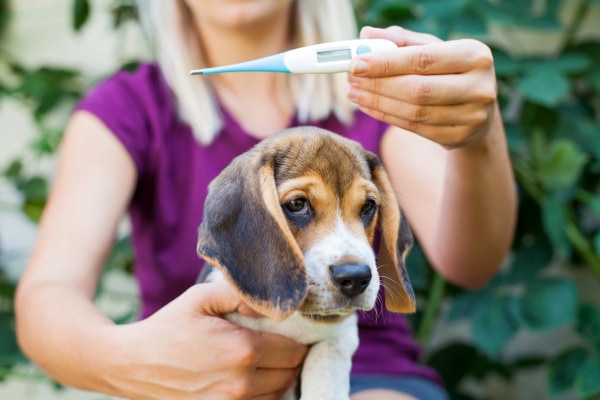
As a pet parent, you know your dog better than anyone else. I’m a firm believer in a mother’s intuition (and a father’s). This often means you can pick up on subtle changes in your dog just by observing him or her. These differences—like a slight hesitation to eat or reluctance to get off the couch—can be early warning signs that something is wrong.
However, these observations are “subjective.”
If you’re ever concerned that your dog isn’t feeling well, taking your dog’s temperature at home—an “objective” measure of health—is a great place to start and valuable information to provide your veterinarian.
Even though your veterinarian may take your dog’s temperature during a physical exam, it is valuable to know what your dog’s temperature is at home. Stress can cause a dog’s temperature to increase and muddy the waters. I once had a perfectly healthy (but very excited) young dog register a temperature of 103.6oF at his veterinary appointment, just from stress and excitement.
Don’t get me wrong. This doesn’t happen for every dog and it certainly doesn’t discount the value of your dog’s temperature reading in the office. But I want to emphasize that the temperature reading you get at home prior to loading your dog into the car and driving to the vet hospital is the most accurate reading if done correctly.
In my experience, it’s very rare for a client to show up having taken their dog’s temperature. Your dog’s temperature is a critical part of home assessment of their status when sick, and also helpful information to provide your veterinarian.
For this reason, I want to teach you how to take a dog’s temperature. But first, you need to understand what constitutes a normal temperature so you will know how to interpret the numbers on the thermometer.
What is the normal dog temperature?
A portion of the brain called the hypothalamus carefully regulates body temperature. This is a good thing because the body functions best at certain internal temperatures.
For people, this temperature is around 98.6oF. However, dogs run much warmer than us. Normal dog body temperature is typically 100o-102.5oF.
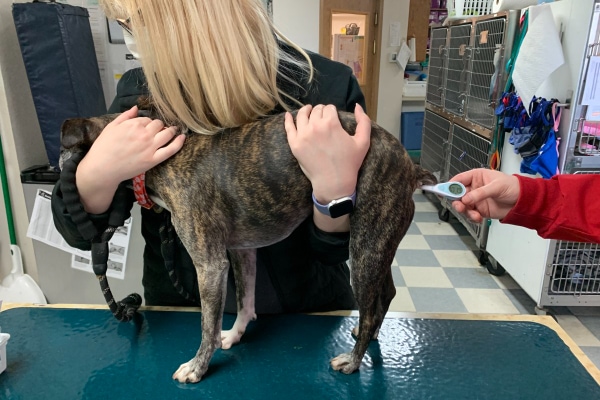
Sometimes though, sickness and other conditions may cause the body temperature to deviate from this normal range. In certain situations, this may not cause lasting issues. For example, fever (i.e. elevated body temperature) is an important component of the immune system’s response to infection. Or if your dog has just been exercising in the heat or is very excited, his or her temperature may be higher (around 103oF) for 10 to 20 mins after coming inside, ceasing exercise, or calming down.
But there are other times when an abnormal temperature becomes problem. If a dog’s internal temperature gets too high or too low, it can cause negative effects on the whole body—including the respiratory and circulatory systems and the brain.
Thus, knowing your dog’s temperature is important. And it is important to know what your dog’s temperature is, especially if you suspect something could be wrong. This is why your vet will assess your dog’s temperature during an office visit. And it is why you should learn how to take your dog’s temperature too.
How do I take a dog’s temperature?
In order to successfully check your dog’s temperature, you need to know three basic things—what kind of thermometer to use, how to do the actual temperature-taking part, and what to make of the temperature reading you obtain.
Choosing a thermometer
The first order of business is thermometer selection. There are many different types of thermometers on the market these days, and some are certainly better than others. In a pinch, you may end up using whatever you have in the house. But if you are going to buy a thermometer to put in your dog first aid kit, knowing a bit more about the pros and cons of each type can be helpful.
Glass thermometers
While glass thermometers are not as readily available in stores anymore, some homes may still have them in the medicine cabinet. However, I do not recommend using a glass thermometer on your dog. If he or she jumps, spins around, or moves quickly while you are taking a temperature, you could drop the thermometer and it could shatter. This is dangerous for you and your dog—especially if you are using an old mercury thermometer.
Non-contact infrared thermometers
During the height of COVID, we grew accustomed to seeing non-contact infrared thermometers in doctor’s offices, childcare facilities, and other locations. These thermometers are handheld and work by using infrared heat waves to measure body temperature with no physical contact. This works great on people because they don’t have a lot of hair covering their skin.
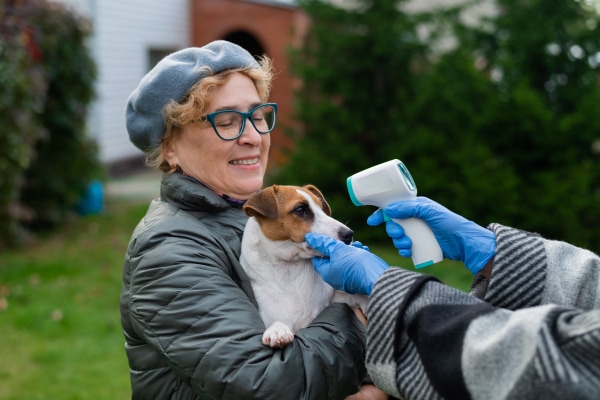
However, studies indicate this thermometer type does not produce an accurate reading in dogs when compared to other thermometers. The infrared waves simply do not read through a dog’s hair as well. And even when used on non-haired areas like the ears or inner thighs, the readings are often a few degrees off.
Therefore, these thermometers are not my first choice. And you shouldn’t use them in critical situations where you need an accurate temperature reading.
However, if your dog is nervous and can be aggressive when handled, this type of thermometer can be a useful way to get an approximate temperature at home. For best results, ensure you point it at areas with less hair like the inner ear or inner thigh. Also, remember to trust your gut. If the temperature reading is normal but you suspect something is wrong with your dog, please consult your veterinarian.
Ear thermometers
Compared to non-contact infrared thermometers, ear thermometers are the better option. Also, they are less-invasive than a rectal thermometer. (I’ll discuss those next.) Ear thermometers have been used for a long time in people and animals and have proven to be effective.
For dogs who are nervous when their temperature is taken or do not like their hind end touched, ear thermometers are my go-to method for pet parents to use at home. And for the same reasons, some veterinarians may use ear thermometers in the office on seemingly healthy dogs as a temperature screening tool.
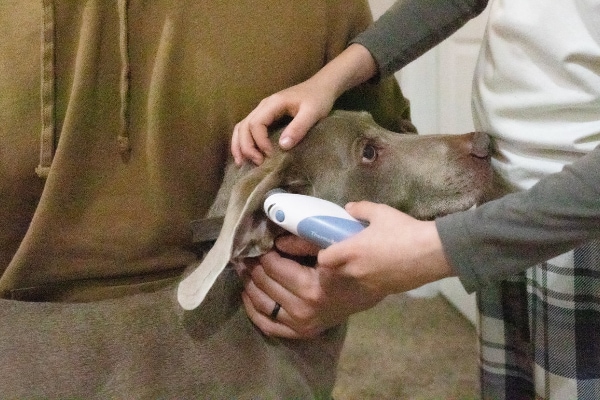
However, since dogs have a very long horizontal ear canal and hairy waxy ears, it is important to know that ear temperatures are still not as accurate as rectal temperatures.
Rectal thermometers
When I refer to a rectal thermometer for dogs, I am actually talking about the digital thermometers that people use in their mouth (or that you can use to obtain rectal temperatures for babies). In dogs, we only use this type of thermometer rectally since a dog would try to swallow it or bite it if used orally.
Hands down, these are my favorite thermometers to use. They are fast and easy to read. Plus, they are the most accurate way to determine your dog’s internal body temperature. However, I recognize that they probably seem more intimidating to dog parents because you have to insert them into the rectum. I promise it isn’t as hard as it sounds, though!
The best two options—rectal thermometers and ear thermometers
If you suspect something is wrong with your dog and want to take his or her temperature, I recommend using a rectal thermometer (ideally) or an ear thermometer (if your dog won’t tolerate a rectal thermometer). Also, if you get an abnormal temperature with the ear thermometer, I typically tell people to verify it by getting a rectal reading if possible.
How to take a dog’s temperature with a rectal thermometer
Since a rectal thermometer is the most accurate way to take your dog’s temperature, I’m going to give you instructions on taking a dog’s rectal temperature first. Then we will get to my second favorite method, using an ear thermometer.
Follow these 10 steps to take your dog’s temperature like a pro:
Prepare your supplies.
1. It is helpful to gather your supplies first. This will help the process be as fast, smooth, and easy as possible for you and your dog.
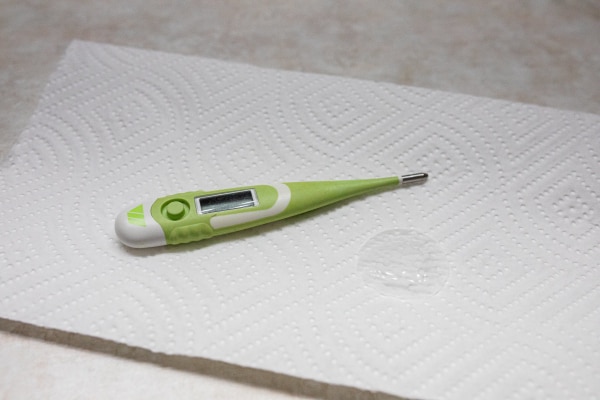
You will need:
- A rectal thermometer (Remember, this is the traditional oral thermometer used in humans.)
- Petroleum jelly or baby oil
- Paper towels
2. Ensure the outside of the thermometer is clean. Then cover the tip generously with petroleum jelly or another water-based lubricant.
Get your dog positioned comfortably
3. Now you are ready to bring your dog over and get him or her situated somewhere secure and comfortable. If your dog is small, he or she can be held in a lap or placed on a table. For larger dogs, I recommend having your dog stand on the floor in a spot where he or she is comfortable and relaxed.
Note: My goal is always to keep you and your dog safe and comfortable. Please carefully consider if you should take your dog’s temperature by yourself, recruit someone to hold your dog for you, or switch to the ear thermometer method.
Whether someone is helping you (step 4a) or you are doing this by yourself (step 4b), it is important to hold your dog still and support the abdomen while taking the temperature.
4a. If someone is helping you, they should stand on one side of your dog. One arm should be under your dog’s abdomen and just in front of the hind legs. The other arm should be under your dog’s neck and gently wrapped upwards toward the head.

4b. If you are holding your dog by yourself, I recommend standing behind your dog. You can put one hand under the abdomen in front of or between the back legs of your dog. This will allow your other hand to be free to lift your dog’s tail.
Insert the thermometer
5. Once you have your dog in a good position, you can carefully lift up the tail with one hand. Remember to be gentle when doing this because there are nerves and bones in the tail.
6. Carefully insert the thermometer into your dog’s rectum but do not use excessive force. For small dogs, the tip of the thermometer should only be inserted about an inch into your dog’s rectum. For larger dogs, it is fine if the thermometer goes in a bit farther (around 2-3 inches).
7. Hit the button to turn the thermometer on. Then hold it in place until it beeps and a digital reading appears. This should only take a few seconds.
Remove the thermometer
8. Carefully pull the thermometer out of your dog’s rectum and read or write down the temperature on the screen.
9. Praise your dog and/or give him or her a treat (assuming your dog isn’t having GI issues). You want to make the experience as positive as possible so your dog sees temperature-taking as no big deal.
10. Clean the end of the thermometer and put it back in your dog first aid kit so it is ready for next time.
Pro tips:
- Use a baby or “fast reading” thermometer. These often take a temperature in 5 seconds or less, making the experience much easier for you and your dog.
- Keep paper towels nearby when taking a rectal temperature or do it outside. Occasionally, some dogs might be stimulated to poop during the process.
- To help temperature-taking be smooth and low-stress when your dog is sick, practice it when your dog is healthy so he or she gets used to it. As an added bonus, knowing your dog’s normal baseline temperature gives you and your vet a useful point of comparison for when your dog is feeling poorly.
How to take a dog’s temperature with an ear thermometer
If your dog is nervous and won’t let you take a rectal temperature, an ear temperature is the next best option. To take your dog’s temperature with an ear thermometer, follow these seven steps.
Gather your supplies and get your dog in position
1. Collect your ear thermometer and ensure the tip is clean. If the thermometer comes with disposable tip covers, place one over the tip. You do not need to apply a lubricating agent like you did with the rectal thermometer.
2. Hold your dog in a secure, comfortable position. You can take an ear temperature with your dog sitting or standing—what ever position is most comfortable for you and your dog. Remember, some dogs don’t like their ears messed with or things stuck in them. In these situations, you might need a second person to hold your dog still for you (as described in step 4a above).
Insert the ear thermometer
3. Gently lift the flap of your dog’s ear up so you can see inside the ear. (Note: Do not clean your dog’s ear immediately prior to taking his or her temperature. The ear cleaning solution could lower the temperature inside your dog’s ear and cause an inaccurate reading.)
4. Carefully insert the ear thermometer into your dog’s ear canal at a 90o degree angle from his or her head (i.e. with the tip aiming down the ear canal) and turn it on. Do not try to force the thermometer deep into your dog’s ear.
Note: If your dog is resisting the thermometer, it might mean the ear is painful and sore. Additionally, if you notice that your dog’s ear is red, full of brown waxy debris, has a yeasty odor to it, or is painful to the touch, he or she may have an ear infection (i.e. otitis in dogs). In this case, please do not keep trying to take an ear temperature. Instead, make an appointment with the veterinarian to have your dog’s ears evaluated.
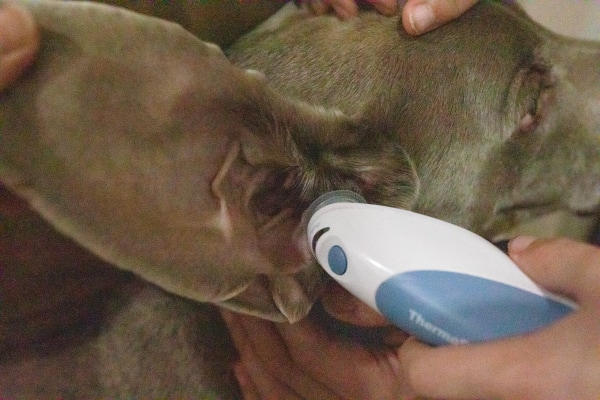
Remove the thermometer
5. Once the thermometer beeps and a digital temperature reading appears, gently remove the thermometer from the ear canal. Read and record the temperature.
6. Praise your dog and reward him or her to keep it a fun and low-stress experience.
7. Wipe any debris from the thermometer and place it back in your dog first aid kit.
Interpreting your dog’s temperature reading
After successfully checking your dog’s temperature, the next order of business is to determine if the number you got falls into the normal range (and if not, what the next step should be). I have listed the various temperature options to make it easier for you to determine the significance of your dog’s temperature reading.
Temperature between 100-102.5oF
A reading between 100-102.5oF is a normal body temperature for a dog. But, keep in mind that the lack of a fever does not guarantee your dog is not sick. If your dog is acting abnormal and/or showing any concerning symptoms, it may still be a good idea to contact your veterinarian.
Temperature over 102.5oF but dog seems normal
If the temperature is higher than 102.5oF and your dog appears fine otherwise, first allow your dog some time to cool down or calm down. It might just mean he or she was outside in the sun or was recently running and playing. This sort of exercise or climate can often cause a dog’s “normal” temperature to be closer to 103oF.
Offer your dog a place to lay down and drink cool water. Then retake your dog’s temperature in 10 minutes. If it is still elevated, assess the situation and consider consulting your veterinarian.
Temperature over 102.5oF and dog seems sick
If the temperature is between 102.5oF and 104oF and your dog is showing other signs, I recommend consulting your veterinarian. This is highly suggestive that your dog might be sick and needs medical attention.
Temperatures higher than 104oF are even more more concerning. Any time your dog’s temperature reads this high, I recommend calling your veterinarian immediately for help.
If your dog’s temperature is extremaly elevated at around 107o-109oF, please immediately take your dog to the nearest veterinary hospital for an emergency vet visit. These high temperatures are dangerous and can rapidly result in damage to your dog’s body and brain. This is an emergency situation.
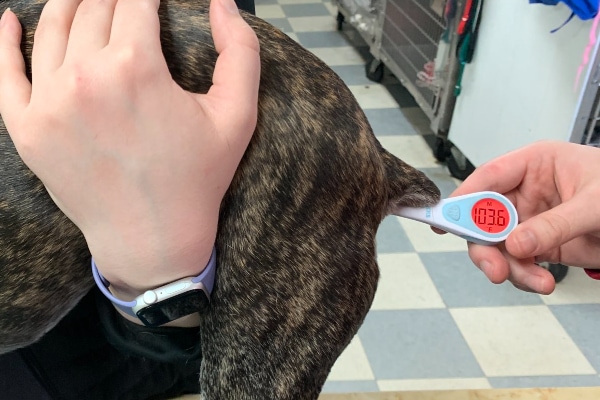
Potential causes of an elevated temperature
Whenever your dog has a fever and seems sick, it can be concerning. To equip you with information, I wanted to make a quick detour and provide some of the more common reasons for fever in dogs. They include:
- Bacterial or viral infection
- Exposure to certain toxins
- Heat stroke in dogs
- Allergic reaction
Your veterinarian will consider your dog’s temperature, history, and other physical exam findings and then make a diagnostic and treatment plan.
Temperature below 100oF and dog seems fine
If your dog’s temperature is reading too low but he or she is acting normal, it may be best to retake the temperature. Sometimes you may have accidentally inserted a rectal thermometer into the feces, which can be a bit cooler than body temperature. Or, improperly positioning an ear thermometer can give an inaccurate reading.
Temperature below 100oF and the dog seems sick
However, sometimes a low temperature isn’t due to an error in technique. If your dog is acting abnormal and the rectal thermometer is consistently reading below 100oF, please take your dog to your veterinarian immediately. A low body temperature can be a sign of a life-threatening condition like sepsis (i.e. what happens when the body’s powerful reaction to an infection begins to cause damage). Or it may occur if a dog is suffering from hypothermia due to prolonged exposure to severe cold. Either way, your dog needs veterinary attention.
Assessing your dog’s vitals (and overall health) can be lifesaving
In instances where your dog’s temperature is dangerously high or low, you may save his or her life by recognizing the emergency and taking him or her to the vet.
But I don’t want you to discount the importance of checking your dog’s temperature as a way to establish a baseline too. Knowing what is normal for your dog can help you and your veterinarian better interpret temperature changes if your dog seems to be ill.
In fact, I recommend not only knowing your dog’s normal temperature, but also knowing his or her other dog vital signs such as heart rate and respiratory rate. And, to take things a step further, you can, and should perform full-body exams of your dog at home on a regular basis. This can be a fantastic way to detect small changes in your dog’s health before they start causing big problems. To help empower you to do this, I created my brand-new course: Dr. Buzby’s Tip-to-Tail Health Scan: 10 Touches That Could Save Your Dog’s Life.
With this in mind, now is the time to take steps to monitor your dog’s health—including learning to take his or her temperature! Your dog will thank you in the end!
Do you regularly take your dog’s temperature?
Please share any tips or tricks with other dog parents.


We welcome your comments and questions about senior dog care.
However, if you need medical advice, diagnosis, or treatment, please contact your local veterinarian.